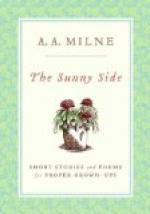THE PATRIOT
This is a true story. Unless you promise to believe me, it is not much good my going on ... You promise? Very well.
Years ago I bought a pianola. I went into the shop to buy a gramophone record, and I came out with a pianola—so golden-tongued was the manager. You would think that one could then retire into private life for a little, but it is only the beginning. There is the music-stool to be purchased, the library subscription, the tuner’s fee (four visits a year, if you please), the cabinet for the rolls, the man to oil the pedals, the—However, one gets out of the shop at last. Nor do I regret my venture. It is common talk that my pianola was the chief thing about me which attracted Celia. “I must marry a man with a pianola,” she said ... and there was I ... and here, in fact, we are. My blessings, then, on the golden tongue of the manager.
Now there is something very charming in a proper modesty about one’s attainments, but it is necessary that the attainments should be generally recognized first. It was admirable in Stephenson to have said (as I am sure he did), when they congratulated him on his first steam-engine, “Tut-tut, it’s nothing”; but he could only say this so long as the others were in a position to offer the congratulations. In order to place you in that position I must let you know how extraordinarily well I played the pianola. I brought to my interpretation of different Ops an elan, a verve, a je ne sais quoi—and several other French words—which were the astonishment of all who listened to me. But chiefly I was famous for my playing of one piece: “The Charge of the Uhlans,” by Karl Bohm. Others may have seen Venice by moonlight, or heard the Vicar’s daughter recite “Little Jim,” but the favoured few who have been present when Bohm and I were collaborating are the ones who have really lived. Indeed, even the coldest professional critic would have spoken of it as “a noteworthy rendition.”
“The Charge of the Uhlans.” If you came to see me, you had to hear it. As arranged for the pianola, it was marked to be played throughout at a lightning pace and with the loudest pedal on. So one would play it if one wished to annoy the man in the flat below; but a true musician has, I take it, a higher aim. I disregarded the “FF.’s” and the other sign-posts on the way, and gave it my own interpretation. As played by me, “The Charge of the Uhlans” became a whole battle scene. Indeed, it was necessary, before I began, that I should turn to my audience and describe the scene to them—in the manner, but not in the words, of a Queen’s Hall programme:—
“Er—first of all you hear the cavalry galloping past, and then there’s a short hymn before action while they form up, and then conies the charge, and then there’s a slow bit while they—er—pick up the wounded, and then they trot slowly back again. And if you listen carefully to the last bit you’ll actually hear the horses limping.”




